
Mehmed III was the sultan of the Ottoman Empire from 1595 until his death in 1603. Mehmed was known for ordering the execution of his brothers and leading the army in the Long Turkish war, during which the Ottoman army was victorious at the decisive Battle of Keresztes. This victory was however undermined by some military losses such as in Gyor and Nikopol. He also ordered the successful quelling of the Jelali rebellions. The sultan also communicated with the court of Elizabeth I on the grounds of stronger commercial relations and in the hopes of England to ally with the Ottomans against the Spanish.

Suleiman I, commonly known as Suleiman the Magnificent in the West and Suleiman the Lawgiver in his realm, was the longest-reigning sultan of the Ottoman Empire from 1520 until his death in 1566. Under his administration, the Ottoman Empire ruled over at least 25 million people.
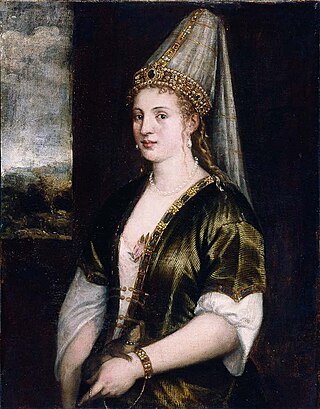
Hürrem Sultan, also known as Roxelana, was the chief consort and legal wife of the Ottoman Sultan Suleiman the Magnificent. She became one of the most powerful and influential women in Ottoman history as well as a prominent and controversial figure during the era known as the Sultanate of Women.
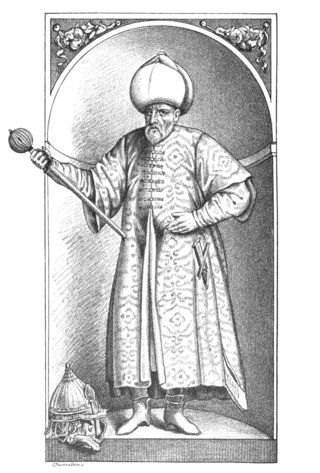
Sokollu Mehmed Pasha was an Ottoman statesman of Serbian origin most notable for being the Grand Vizier of the Ottoman Empire. Born in Ottoman Herzegovina into an Orthodox Christian family, Mehmed was forcibly recruited as a young boy as part of so called "blood tax" to serve as a janissary to the Ottoman devşirme system of recruiting Christian boys to be raised as officers or administrators for the state. He rose through the ranks of the Ottoman imperial system, eventually holding positions as commander of the imperial guard (1543–1546), High Admiral of the Fleet (1546–1551), Governor-General of Rumelia (1551–1555), Third Vizier (1555–1561), Second Vizier (1561–1565), and as Grand Vizier under three sultans: Suleiman the Magnificent, Selim II, and Murad III. He was assassinated in 1579, ending his near 15-years of service to several Sultans, as sole legal representative in the administration of state affairs.

Mimar Sinan also known as Koca Mi'mâr Sinân Âğâ, was the chief Ottoman architect, engineer, mathematician for sultans Suleiman the Magnificent, Selim II and Murad III. He was responsible for the construction of more than 300 major structures such as the Selimiye Mosque in Edirne, the Kanuni Sultan Suleiman Bridge in Büyükçekmece, the Mehmed Paša Sokolović Bridge in Višegrad, and other more modest projects such as madrasa's, külliye's, bridges, etc. His apprentices would later design the Sultan Ahmed Mosque in Istanbul and Stari Most in Mostar.

Ottoman architecture is an architectural style or tradition that developed under the Ottoman Empire over a long period, undergoing some significant changes during its history. It first emerged in northwestern Anatolia in the late 13th century and developed from earlier Seljuk Turkish architecture, with influences from Byzantine and Iranian architecture along with other architectural traditions in the Middle East. Early Ottoman architecture experimented with multiple building types over the course of the 13th to 15th centuries, progressively evolving into the classical Ottoman style of the 16th and 17th centuries. This style was a mixture of native Turkish tradition and influences from the Hagia Sophia, resulting in monumental mosque buildings focused around a high central dome with a varying number of semi-domes. The most important architect of the classical period is Mimar Sinan, whose major works include the Şehzade Mosque, Süleymaniye Mosque, and Selimiye Mosque. The second half of the 16th century also saw the apogee of certain decorative arts, most notably in the use of Iznik tiles.
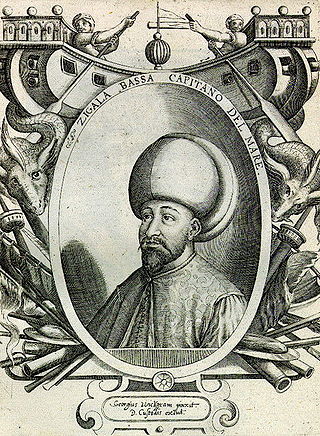
Cığalazade Yusuf Sinan Pasha, his epithet meaning "son of Cicala", was an Ottoman Italian statesman who held the office of Grand Vizier for forty days between 27 October to 5 December 1596, during the reign of Mehmed III. He was also a Kapudan Pasha as well as a military general. He was one of the most capable statesmen of the Ottoman Classical Age, having contributed to the eastwards expansion of the empire at the expense of Persia and successfully defended Ottoman Hungary from Habsburg invasion. However, because of court intricacies, he resigned from the Vizierate after just over a month in office.

Elif Shafak is a Turkish-British novelist, essayist, public speaker, political scientist and activist.
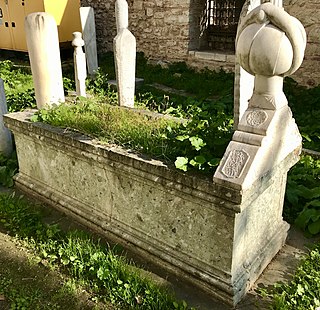
Sinanuddin Yusuf Pasha or in short Sinan Pasha, was an Ottoman Grand Admiral, who served the Ottoman Navy for nearly four years between 1550 and the end of 1553, during the reign of Suleiman the Magnificent. He was of Serbian or Croatian descent, the predecessor of Piali Pasha in this rank and the brother of Grand Vizier Rustem Pasha, who in turn was married to Mihrimah Sultan, a daughter of Suleiman the Magnificent and Hurrem Sultan.

The Mimar Sinan Fine Arts University is a Turkish public university dedicated to higher education in the fine arts. It is located in the Fındıklı neighbourhood of Beyoğlu, Istanbul, Turkey.

A külliye is a complex of buildings associated with Turkish architecture centered on a mosque and managed within a single institution, often based on a waqf and composed of a madrasa, a Dar al-Shifa (clinic), kitchens, bakery, hammam, other buildings for various charitable services for the community and further annexes. The term is derived from the Arabic word kull "all".

The Şehzade Mosque is a 16th-century Ottoman imperial mosque located in the district of Fatih, on the third hill of Istanbul, Turkey. It was commissioned by Suleiman the Magnificent as a memorial to his son Şehzade Mehmed who died in 1543. It is sometimes referred to as the "Prince's Mosque" in English. The mosque was one of the earliest and most important works of architect Mimar Sinan and is one of the signature works of Classical Ottoman architecture.

Rüstem Pasha was an Ottoman statesman who served as Grand Vizier to Sultan Süleyman the Magnificent. Rüstem Pasha is also known as Damat Rüstem Pasha as a result of his marriage to the sultan's daughter, Mihrimah Sultan, in 1539. He is regarded as one of the most influential and successful grand viziers of the Ottoman Empire.
Şemsi Pasha, also known as Chamsi-Pasha, was a distinguished Ottoman nobleman and beylerbey who occupied several high-ranking posts, serving at various stages as the Ottoman governor-general of the beylerbeyliks of Damascus, Anatolia and Rumeli.
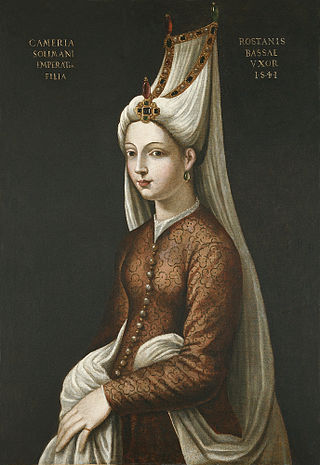
Mihrimah Sultan was an Ottoman princess, the daughter of Ottoman Sultan Süleyman the Magnificent and his wife, Hürrem Sultan. She was the most powerful imperial princess in Ottoman history according to historian Mustafa Selaniki who described her as the greatest and most respected princess and a prominent figure in the so-called Sultanate of Women. In Europe she was known as Sultana Cameria, while in Constantinople she was known as Büyük Sultan.

The Bastard of Istanbul is a 2006 novel by Turkish bestselling author Elif Shafak, written originally in English and published by Viking Adult. It was translated by Aslı Biçen into her native language Turkish under the title Baba ve Piç in March 2006, and became a bestseller.

The Forty Rules of Love is a novel written by the Turkish author Elif Shafak, Her interest in writing this book was influenced by the degree she received in Gender and Women’s Studies. The book was published in March 2009. It is about Maulana Jalal-Ud-Din, known as Rumi and his companion Shams Tabrizi. This book explains how Shams transformed a scholar into a Sufi (mystic) through love. More than 750,000 copies of this book were sold in Turkey and France.

Three Daughters of Eve is a 2016 novel by Turkish writer Elif Safak. In many places, the book was recalled and retitled Confused Quest. The book centres on a wealthy, middle-aged housewife, her childhood in Istanbul and her time as a student at Oxford University where she fell in love with a philosophy professor. It focuses on her categorizing her identity. The book was featured on several lists of "best books" in 2018.
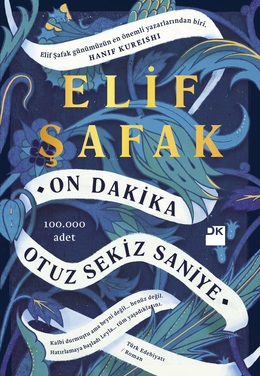
10 Minutes 38 Seconds in This Strange World is a 2019 novel by Turkish writer Elif Shafak and her eleventh overall. It is a one-woman story about a sex worker in Istanbul. It was released by Viking Press in 2019.

Classical Ottoman architecture is a period in Ottoman architecture generally including the 16th and 17th centuries. The period is most strongly associated with the works of Mimar Sinan, who was Chief Court Architect under three sultans between 1538 and 1588. The start of the period also coincided with the long reign of Suleiman the Magnificent, which is recognized as the apogee of Ottoman political and cultural development, with extensive patronage in art and architecture by the sultan, his family, and his high-ranking officials.



















